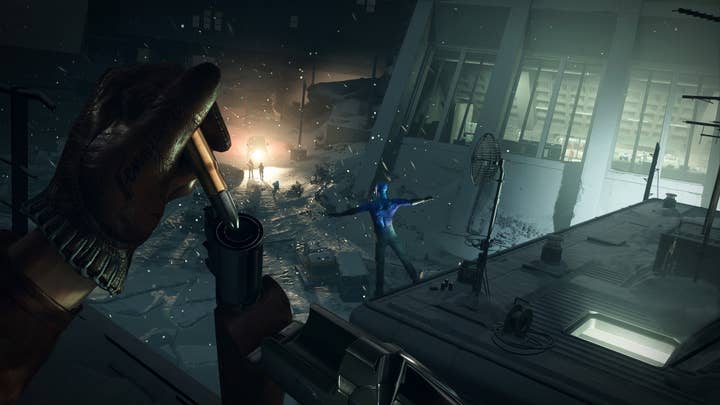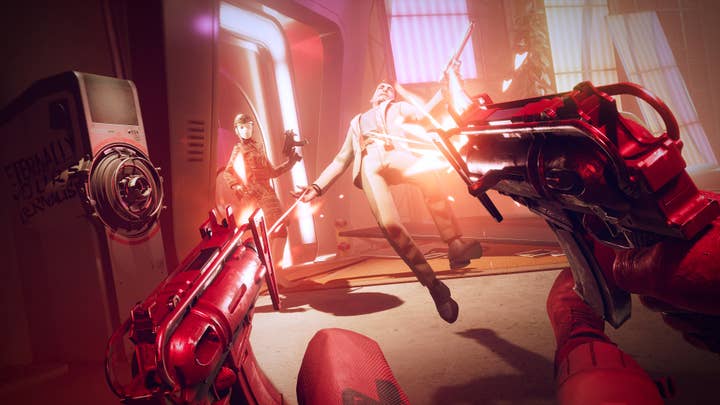Clear goals and organic paths: The Arkane guide to player agency
Arkane Lyon's campaign director Dana Nightingale discusses how to empower players and earn their trust
Play your way. That's the promise of a multitude of games, from the open-world antics of Far Cry 6, to the timeloop thrills of Deathloop, to the choice-driven zombie apocalypse of the upcoming Dying Light 2.
The notion implies a level of interactivity that goes beyond the traditional shooting galleries found in the likes of Call of Duty or strict solutions to most puzzle titles. It raises player expectations about the agency they have over everything, from story to the minute-to-minute events of the game in question.
It's perhaps the ultimate selling point for a video game, especially as the medium has become so advanced and such agency is increasingly possible -- but how do you deliver on that as a developer?
First, it's probably worth thinking about what player agency means. Arkane Lyon's campaign director Dana Nightingale describes it as "a combination of a player knowing what they want to do and knowing how to achieve it -- or at least knowing how to attempt to achieve it -- with a relative certainty that this thing they're attempting makes sense within the game's rules."

Nightingale has worked on every Dishonored title as a level designer, a position she initially had on Deathloop before she was elevated to campaign designer (and then promoted this week to campaign director). The campaign designer role can mean different things on different games, but in her case it meant overseeing the player's critical path through the game -- or, as she puts it, making her the "author of the murder puzzle" at Deathloop's core.
We asked Nightingale for more insight into how developers can give agency to their players.
Set clear goals
First and foremost, developers need to teach players three things:
- What their objective is
- What challenges are preventing them from completing it
- What tools they have to overcome those challenges
"You can get into a lot more detail on that pattern," says Nightingale. "They have to understand what the reward will be, what the benefit of the reward is to them. So, there are deeper levels, but the high level of that chart is you always have to keep that pattern. The first thing the player wants to know is, 'Why am I doing this? What's the point of all this?'"
Clear goals don't necessarily have to be structural or narrative. Challenging the player to demonstrate their skills at using the tools given to them is a valid and often satisfying objective, but that still needs to be made clear. If players aren't clear about what's expected of them at any given moment, it will sour their opinion of your game.
"They might be like, 'Hey, am I in a game where there's an end to this map and my goal right now is to reach the end of the map? Or are the enemies just going to keep coming forever and my goal right now is just to get a high score?' If the player doesn't know which it is, that can lead to frustration."
Open multiple paths
Organic worldbuilding is also central to another element of enabling agency: allowing players to choose their route through each area. While the industry is a long way from the literal 'corridor shooters' of decades past, there are still titles where a choice of route can ultimately boil down to going left or right.
"Is the goal to reach the end of the map? Or are enemies just going to keep coming and the goal is to get a high score? If the player doesn't know which, that can lead to frustration"
Not everything needs to be a fully open world, of course, but building levels and environments in a way that allows players to explore them in different ways can be a big part of empowering them.
"First of all, think about the location, how it would actually work, and the layout of the buildings," Nightingale says. "What's close to each other? What's different? How big is the space? What kind of rooms exist in this house? You're not necessarily building the level like that, but when you start thinking about it that way, all the pathways just come naturally, because real spaces aren't designed like video game maps. They're porous. They're sponges. You can go any which way.
"From that approach, we actually have to start to narrow it down because there's a point where the paths are so overwhelming that the player doesn't know where they're going, and they're turning in circles and getting lost."
A prime example is the bank heist mission from Dishonored: Death of the Outside. Players can either drop in from the roof, sneak in through the sewers, or get in via the sanitation and rubbish disposal system. Arkane treated this like a flowchart, establishing a puzzle that needed to be solved for each entry point and designed the rest of the building -- interior and exterior -- around that.

Conversely, Aleksis Dorsey's mansion in Deathloop was designed the other way: as a place first.
"The ways in and out arose organically from that. I didn't think about, 'What are the cool ways in and out of this?' It was more like, 'What kind of place would this guy live in? What kind of place would be cool for this party?' And I designed it first as this rich asshole's mansion, and then a place for a crazy party, and then all the infiltration and exfiltration routes grew naturally out of that."
"Real spaces aren't designed like video game maps. They're porous. They're sponges. You can go any which way"
However, she offers a word of caution: you don't always have to, nor should you, maximise the use of the entire space. While it's important to give players plenty they can do and interact with, it's also key to give them areas where they can catch their breath and regroup.
"Spaces start to lose meaning if you feel like every single square inch is planned out for content," she says. "The empty spaces, the quiet moments, the spots where nothing is happening are as integral to the experience as everything around it. So, I actually have to be careful to say, 'Okay, this is an area in the map where nothing in particular is happening. And that's kind of interesting.' That's kind of cool.'
"Players need room to just be curious and explore. And if you always find something everywhere, things stop really meaning anything. It's like the discovery doesn't matter anymore because you knew you were going to find something. In a game where there's always a chest behind every waterfall, you get mad as soon as there's no chest behind the waterfall. Whereas if it were one chest behind the tenth waterfall, then you're excited. That's a cool moment. So, you have to make sure that the rewards aren't expected so they still can surprise you and feel satisfying. There should always be a chest behind every waterfall, by the way. That's a video game rule."
Avoid hand-holding where possible
Players want to feel like they have made decisions by themselves, that their actions are their own. Developers may want to suggest players dispatch enemies in a certain way, or take an optimal path to a set destination, but signposting this too blatantly along the way robs players of their agency and feeling of power.
Nightingale notes this is a "massive user experience [challenge]," one that relies on the combined expertise of level designers, narrative designers and UI designers to solve, anticipating as much of players' actions and expectations as possible.
Delivering the information players need to achieve their goals or understand the agency they have can take many forms, whether it's in the design of the level (think about the use of red in Mirror's Edge to indicate potential routes), conveyed through the narrative or even a simple pop-up box.

User research is the key here, says Nightingale, adding: "You send it off to be tested, and you find out everything was wrong anyway and none of it works. So then you pay very close attention to the players' reactions, you rely on the expertise of the user research specialists, because they're the ones analysing the players' behaviour, and you try again. And you try it again and again and again, and eventually, hopefully, you solve it. But there's no magic process to solving that, as far as I've discovered in my career."
She adds: "I think we had some successes in Deathloop, a few cases where we had to just hit it with a sledgehammer and hope, but it was always a give and take between the combination of players [and] expert consultants, and just using all of those resources to help us figure out where we're failing to communicate to the player a combination of what the game expects of them and what's possible for them to do. And when those line up, that's when the player stops thinking about, 'How do I play this game?' And then they just play."
Account for different playstyles
Stealth or all guns blazing. It's perhaps an overly binary view of player agency in titles like those Arkane produces, but a good way to convey the adaptability of the gameplay. Enabling players to proceed in the manner of their choosing is a vital element to giving them agency in progressing through your game, but enabling this requires thoughtful design.
"In a game where there's always a chest behind every waterfall, you get mad as soon as there's no chest behind the waterfall"
In Arkane's case, Nightingale says much of it comes down to building worlds in a very organic way and ensuring plenty of flexibility with any systems-based mechanics -- that way, different playstyles are already accounted for because the game just allows it.
"If we know that we really want to showcase this particular mechanic, we can then build with one playstyle in mind, but we always have to make sure that everything is still supported, because we don't want to take away the agency," she says. "If the player wants to stealth through this combat arena, we still have to allow it. But we'll come at it from different directions depending on what our goals are, the place in the game it is, what the gameplay in this space could be saying about the narrative and vice versa."
Nightingale observes that there may be thematic or story reasons why, in some sections of a game, the developer wants to push players towards one style of gameplay more than the other. Even if that's the case, the expectation should be made clear from the start.
Of course, enabling multiple playstyles introduces a high level of player unpredictability, but Nightingale emphasises the importance of QA and testing in not only identifying but also adapting to this. Famously, when the Arkane team found testers were trying to teleport up to the rooftops in order to bypass chunks of each level in Dishonored, they didn't limit their ability to do so -- they made the rooftops wider.

Build trust with the player
Finally, Nightingale adds that, even in a game like Deathloop -- which encourages players to experiment with every area they explore and every encounter they have -- player agency can vary across the course of the title. But those variations must be made clear to the player.
She offers a hypothetical example of a shooter where there's plenty of dialogue enabling players to talk enemies down, but that also features sections where gunfights are unavoidable.
"You feel like [you] want to be able to talk to [your] adversary here and work [your] way out of it, because that worked the last four times in the game,'" she explains. "But the game[doesn't] allow that. We don't even let you talk with them. And that might be a moment where the player feels like some agency was taken away from them, because one of the tools in their kit was taken away.
"We always try to make sure that if we ever do something like that, that it's understood and it makes sense in the context. So, even though what the player's agency is will ebb and flow over the course of the game, because [of] content constraints, the player should always be aware of what that is, so they're not fighting against the systems. 'I feel like I should be able to jump over this. I was able to jump over things that looked just like this a few minutes ago. Why can't I jump over this one?' That's where the player has lost their agency."
This emphasises the need to build trust. Developers must trust players to know what they can do in any given situation, and players must trust that developers will enable them to do so (or at least understand why any limitations exist).
"If, as a player, I don't trust this game, as soon as I encounter some friction, I'm either quitting or I'm checking a walkthrough, because I don't trust that the game is giving me content where if I put in a little bit more effort, I'll be rewarded," she says.
"It's really important as early as possible in the game to build that trust, so the player feels like if [they] push just a little harder here, the game will make it worth [their] while, instead of being like, 'Okay, that didn't work, therefore the game is broken, so I'm quitting.' That's the way the game is designed, but it might look like a bug because the player hasn't built that trust with the experience yet.
"That's something that I keep in my mind when playing: you have to be able to trust the game."

